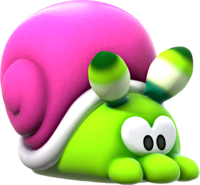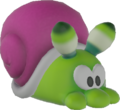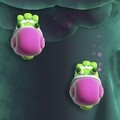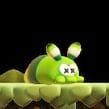Swirlypod: Difference between revisions
(added two images for shellless snails) |
No edit summary |
||
| Line 16: | Line 16: | ||
Snail model SMBW.png|Model | Snail model SMBW.png|Model | ||
SMBW_screenshot_Climby_Snail.png|In-game | SMBW_screenshot_Climby_Snail.png|In-game | ||
snailScale.jpg|Two Snails scaling a wall | |||
SnailDizzy.jpg|A stunned Snail after its shell has been removed | SnailDizzy.jpg|A stunned Snail after its shell has been removed | ||
SnailShellless.jpg|A Snail outside of its shell | SnailShellless.jpg|A Snail outside of its shell | ||
Revision as of 19:27, January 1, 2024
The title of this article is official, but it comes from development data such as an internal filename. If an acceptable public source is found, then the article should be moved to its appropriate title.
| Swirlypod | |||
|---|---|---|---|
 Rendered game model of Snail | |||
| First appearance | Super Mario Bros. Wonder (2023) | ||
| |||
| |||
Snails are enemies from Super Mario Bros. Wonder that are introduced in the level Bulrush Coming Through!. They are green snails with a pink shell. As snails, they move slowly both on the ground, on the sides of a pipe and on floating blocks, but some are also seen climbing up background walls of Semisolid Platforms front side. When stomped, they are launched out of their shells, much like Beach Koopas, and, after recovering from the dizziness, attempt to get back in it. When Snails are eaten by Maw-Maws, their shells are spat out. Similar to Koopa Shells, their shell can then be picked up and used as a weapon or projectile against other enemies.
They are more prominent in the level Swamp Pipe Crawl, where the emerging pipes reveal they can withstand the poison without repercussion.
Big variants also appear in some levels with them with the same characteristics.
Gallery
Names in other languages
| Language | Name | Meaning |
|---|---|---|
| Japanese | マイマイ[1] Maimai |
Snail |
| Italian | Kiocciola[2] |
Pun on "chiocciola" (snail) |
Trivia
- The snails' bulbous, striped antennae strongly resemble the green-banded broodsac, a parasitic flatworm that infests the eyestalks of snails.
References
- ^ 2023年12月28日発売! 圧巻の640ページに凝縮された「スーパーマリオブラザーズ ワンダー 完全攻略本」 – Nintendo DREAM WEB. Nintendo DREAM WEB. Retrieved December 26, 2023.
- ^ Swamp Pipe Crawl's Italian name: "Kiocciole sui tubi paludosi"




